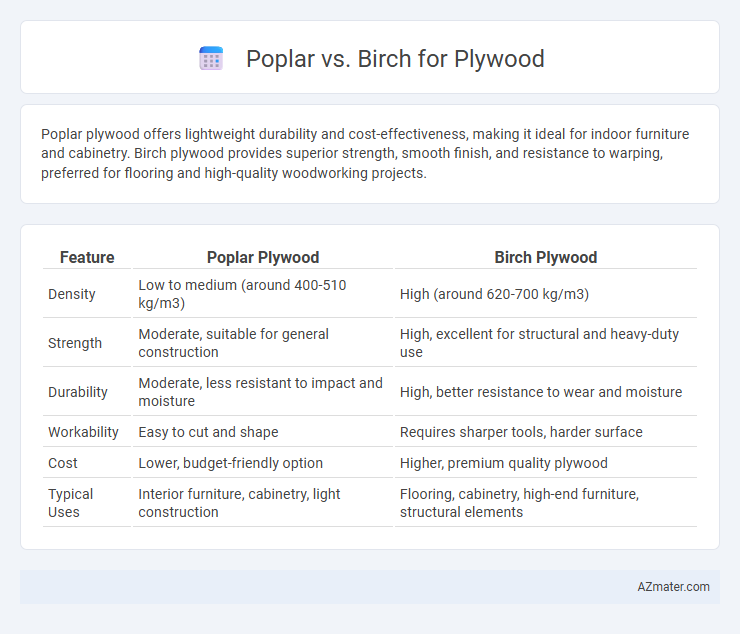Poplar plywood offers lightweight durability and cost-effectiveness, making it ideal for indoor furniture and cabinetry. Birch plywood provides superior strength, smooth finish, and resistance to warping, preferred for flooring and high-quality woodworking projects.
Table of Comparison
| Feature | Poplar Plywood | Birch Plywood |
|---|---|---|
| Density | Low to medium (around 400-510 kg/m3) | High (around 620-700 kg/m3) |
| Strength | Moderate, suitable for general construction | High, excellent for structural and heavy-duty use |
| Durability | Moderate, less resistant to impact and moisture | High, better resistance to wear and moisture |
| Workability | Easy to cut and shape | Requires sharper tools, harder surface |
| Cost | Lower, budget-friendly option | Higher, premium quality plywood |
| Typical Uses | Interior furniture, cabinetry, light construction | Flooring, cabinetry, high-end furniture, structural elements |
Introduction: Poplar vs Birch Plywood
Poplar plywood offers lightweight strength and affordability, making it ideal for furniture and cabinetry where cost efficiency and ease of handling matter. Birch plywood provides superior durability and a smooth, fine grain, favored in applications requiring a high-quality finish and enhanced structural integrity. Both materials serve distinct purposes, with poplar excelling in economy and birch in robustness and aesthetic appeal.
Wood Characteristics: Poplar and Birch Overview
Poplar plywood is lightweight with a fine, uniform texture and moderate strength, making it ideal for applications requiring easy machining and painting. Birch plywood is denser and harder, offering superior durability, smooth surface, and excellent resistance to wear, preferred for furniture and cabinetry. Both woods have consistent grain patterns, but birch's higher density contributes to greater impact resistance compared to poplar.
Appearance and Grain Differences
Poplar plywood features a light, creamy color with a subtle, uniform grain pattern that provides a smooth and consistent appearance ideal for painting or staining. Birch plywood displays a warmer, slightly reddish hue with a pronounced, fine grain that offers a more textured and natural wood look, making it popular for visible applications like cabinetry and furniture. The choice between poplar and birch plywood depends largely on aesthetic preferences and the desired finish, with poplar offering a more neutral base and birch showcasing richer grain detail.
Strength and Durability Comparison
Poplar plywood offers moderate strength with lightweight properties, making it suitable for interior applications, while birch plywood is notably stronger and more durable due to its tight grain structure, ideal for both structural uses and heavy-duty projects. Birch plywood has superior resistance to wear and impact, ensuring longer lifespan and enhanced load-bearing capacity compared to poplar. When durability and strength are critical, birch plywood is preferred for furniture, cabinetry, and flooring, whereas poplar plywood is commonly chosen for affordable, non-structural purposes.
Workability and Ease of Machining
Poplar plywood offers superior workability due to its softer texture, allowing for easy cutting, shaping, and sanding, which makes it ideal for intricate woodworking projects. Birch plywood, while denser and harder, provides smoother edges and less splintering during machining, resulting in a cleaner finish but requiring more effort and sharper tools. Both types machine well, but poplar is preferred for complex detailing, whereas birch is favored for durability and precision in panels and furniture components.
Cost and Availability
Poplar plywood is typically more affordable and widely available due to the rapid growth and abundant supply of poplar trees, making it a cost-effective choice for budget-conscious projects. Birch plywood offers greater durability and strength but comes at a higher price and can be less readily available depending on the region, as birch trees grow slower and are less abundant. Both options vary in price and supply based on geographic location and market demand, influencing project cost efficiency and material accessibility.
Environmental Impact and Sustainability
Poplar plywood is favored for its rapid growth rate and lower environmental footprint, as it requires less water and fewer pesticides compared to birch. Birch plywood, although denser and more durable, often involves harvesting from slower-growing trees, leading to higher ecological costs and less sustainable sourcing. Choosing poplar plywood supports forest regeneration and reduces carbon emissions, making it a more environmentally responsible option for sustainable construction and furniture.
Common Applications in Woodworking
Poplar plywood is favored in woodworking for its lightweight and smooth surface, making it ideal for furniture frames, cabinetry, and painted projects. Birch plywood offers superior strength and durability, commonly used in flooring, cabinetry fronts, and structural applications where a hard, stable wood is required. Both woods provide versatile options, with poplar excelling in easy-to-finish tasks and birch preferred for projects demanding robust wear resistance.
Pros and Cons: Poplar vs Birch Plywood
Poplar plywood offers lightweight strength, smooth surface for painting, and affordability, making it ideal for interior projects and cabinetry, while its softness can lead to dents and less durability under heavy use. Birch plywood is stronger and more stable, with a fine grain that holds screws well, perfect for furniture and high-stress applications, but it is heavier and generally more expensive than poplar. Choosing between poplar and birch plywood depends on project requirements for durability, finish quality, and budget constraints.
Choosing the Right Wood for Your Project
Poplar plywood offers excellent workability and a smooth surface, making it ideal for furniture and cabinetry requiring paint or veneer finishes. Birch plywood is prized for its strength and durability, providing a harder, stable core suited for heavy-use applications like flooring or structural elements. Selecting the right wood depends on balancing budget, finish preference, and required strength for optimal performance in your specific project.

Infographic: Poplar vs Birch for Plywood
 azmater.com
azmater.com